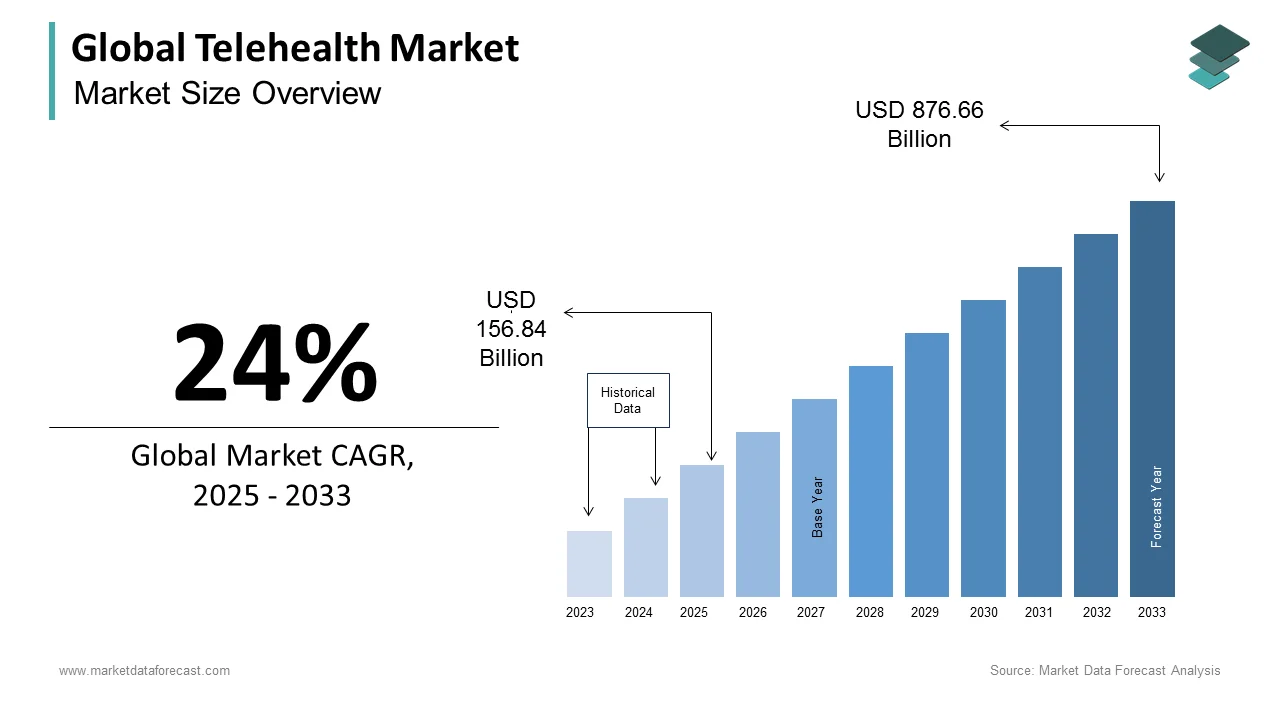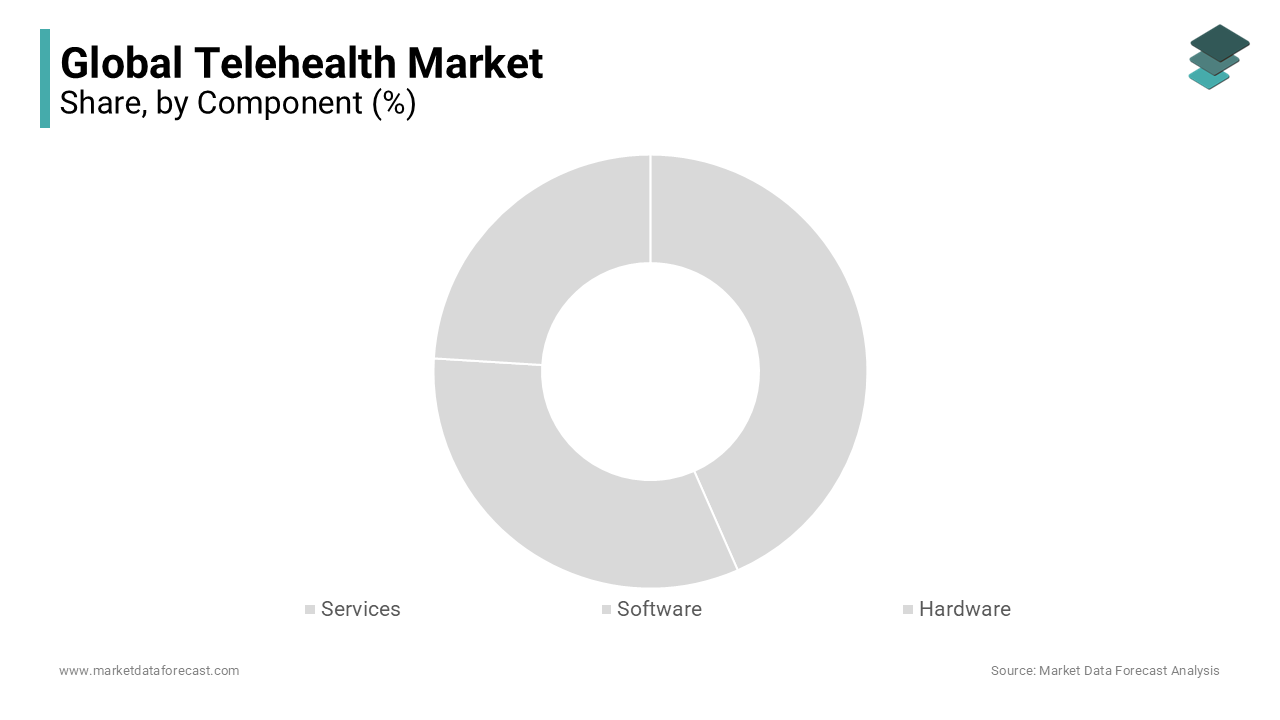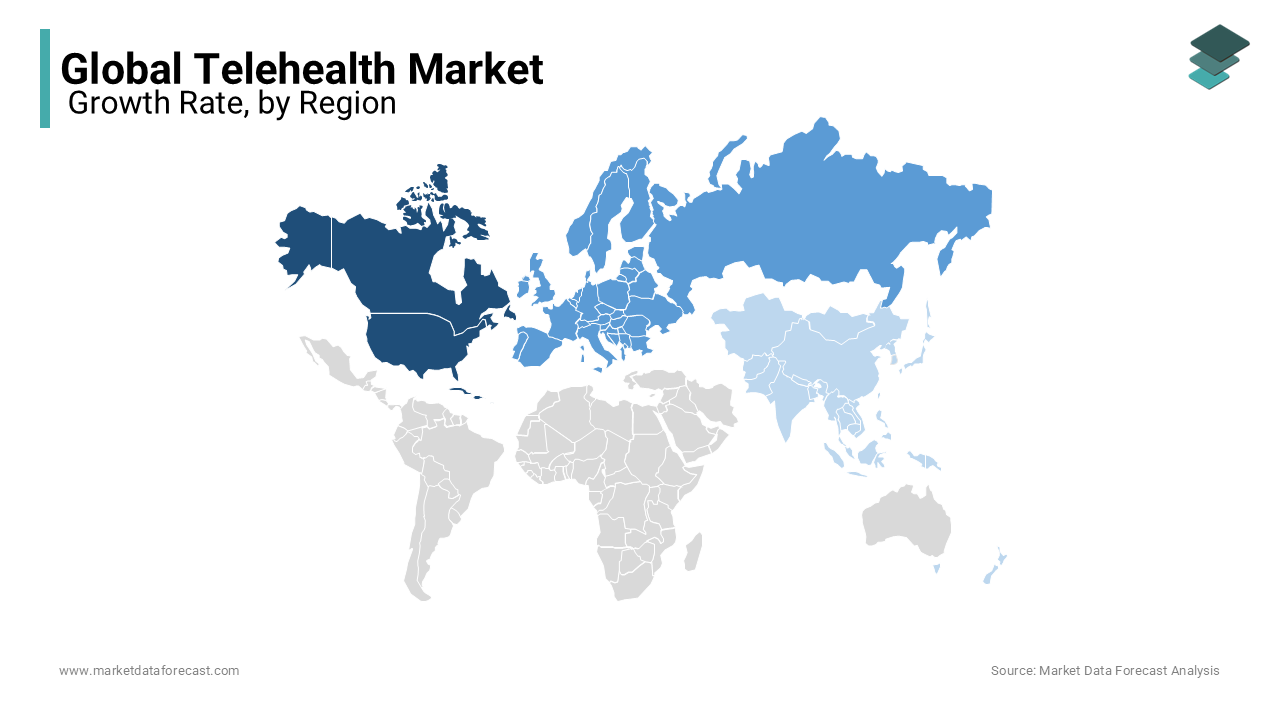Global Telehealth Market Size, Share, Trends & Growth Forecast Report By Component (Services, Software and Hardware), Delivery Mode (Web-based, Cloud-Based and On-premises), End Users (Providers, Patients, Payers and Others) and Region (North America, Europe, Asia-Pacific, Latin America, Middle East and Africa), Industry Analysis From 2025 To 2033.
Global Telehealth Market Size
The size of the global telehealth market was worth USD 126.48 billion in 2024. The global market is anticipated to grow at a CAGR of 24% from 2025 to 2033 and be worth USD 876.66 billion by 2033 from USD 156.84 billion in 2025.

The combination of communication, computer science, and medical technologies is greatly shaping the healthcare industry. It is now possible to treat emergency cases even from far or remote areas by simply connecting to the internet services. Advanced technologies in the healthcare industry are overcoming all the barriers to healthcare providers treating patients remotely. The wide spread of telehealth applications has grown rapidly with the penetration of the COVID-19 pandemic. These services enormously helped healthcare providers during this period as many patients could get treated even by not visiting the hospitals physically but by connecting to the doctors remotely through applications. The trend is continuing in many countries, and that will eventually pose huge opportunities for the market in the coming years.
MARKET DRIVERS
The rising prevalence of various diseases and the need to monitor patients from varied locations are major factors for the market's growth.
Chronic illnesses like cancer, diabetes, cardiovascular diseases, and others are rising in recent times due to the adoption of sedentary lifestyles. The prominence of treating a huge number of patients using the most advanced technologies is the present trend in the healthcare industry.
Huge investments in research and development activities with telehealth and POC technologies are expected to improve the future of the healthcare industry, which will also increase the market's growth rate. For instance, National Institute of Biomedical Imaging and Bioengineering scientists are likely to launch a 15-minute paper-based viral diagnostic for HIV patients. This technology detects the viral load of HIV using a mobile phone to power and control the paper-based RNA extraction and reaction. The technique is to analyze the viral load and indicate through the fluorescent reading.
MARKET RESTRAINTS
However, reluctance to adopt the new technologies in rural areas due to lack of sufficient knowledge is slightly to limit the growth rate of the market. People living in remote or rural areas do not have huge access to the Internet of Things, which is likely to challenge companies to make a standard position in these areas. In addition, the high cost of installation and maintenance of the proper equipment, which is launched with the latest features, is likely to hinder the market's growth rate.
REPORT COVERAGE
|
REPORT METRIC |
DETAILS |
|
Market Size Available |
2024 to 2033 |
|
Base Year |
2024 |
|
Forecast Period |
2025 to 2033 |
|
CAGR |
24% |
|
Segments Covered |
By Component, Delivery, End Users, and Region. |
|
Various Analyses Covered |
Global, Regional, and country-level analysis; Segment-Level Analysis, DROC; PESTLE Analysis; Porter’s Five Forces Analysis, Competitive Landscape; Analyst Overview of Investment Opportunities |
|
Regions Covered |
North America, Europe, APAC, Latin America, Middle East & Africa |
|
Market Leaders Profiled |
American Well, GlobalMed, Teladoc Health, Inc., Dictum Health Inc., InTouch Technologies, Inc., Doctor on Demand, Inc., MDLIVE Inc., Encounter Telehealth, HelloMD, SnapMD, Inc, and Others. |
SEGMENTAL ANALYSIS
By Component Insights
The services segment is leading with the dominant share of the market, whereas the software segment is expected to hit the highest CAGR by the end of the forecast period. People are now more aware of the over-the-counter products where the diagnosis of diabetes, BP, and others has become so easy. The convenience of getting a diagnosis simply at home with the available products, which are digitalized, substantially enhances the growth rate of these segments.

By Delivery Insights
The cloud-based segment holds the largest share of the telehealth market. The growing load to store data in the healthcare industry is only possible with cloud-based technology. Retrieving the medical history of the patient, which is stored in the cloud, is simple and easy for healthcare providers, which helps them to treat more accurately and efficiently.
The web-based segment is esteemed to have prominent growth opportunities. Small and medium-scale industries should adopt this delivery method to anticipate healthcare applications.
By End Users Insights
The patients segment led the dominant share of the telehealth market. The increasing number of patients and the demand to promote high-quality treatment procedures using these new technologies highlight the market's growth rate. Providers and payers are all set to grow steadily throughout the forecast period.
REGIONAL ANALYSIS

North America is leading with the largest share of the telehealth market. The presence of the top leading companies in developed countries like the US and Canada is augmented in leveraging the growth rate of the market. The increasing incidences of cancer and other chronic diseases where there is high importance to continuously monitor the patient's vital signs are solely possible with telehealth services.
Asia Pacific is next in holding the dominant share of the market owing to the increasing number of geriatric populations. Elderly people highly need quality healthcare services remotely as they cannot visit hospitals more often. Telehealth services are highly successful in treating old age people from various locations more effectively.
Europe is likely to have a significant growth rate in the telehealth market. High per capita income and growing expenditure on healthcare are driving the growth rate of the market.
KEY MARKET PARTICIPANTS
American Well, GlobalMed, Teladoc Health, Inc., Dictum Health Inc., InTouch Technologies, Inc., Doctor on Demand, Inc., MDLIVE Inc., Encounter Telehealth, HelloMD, and SnapMD, Inc. are a few of the global telehealth market leaders profiled in this report.
RECENT MARKET DEVELOPMENTS
- InTouch has developed a virtual platform for providing enhanced healthcare solutions called 'solo,' which has direct-to-customer, direct-to-patient, and improved emergency care solutions. InTouch launched the product in 2019, contributing to the growth of the telehealth market.
- Nutrimedy is a new type of telemedicine that provides patients with evidence-based clinical nutrition management directly at home. With this solution, companies can create personalized patient programs offered by clinical professionals, combined with customized interventions to support the patient population, making this company unique proactively. The Top Telehealth Company Nutrimedy is an early start-up company that improves clinical nutrition care models through telemedical and mobile platforms. As a result, a clinical dietitian can provide personalized care outside the hospital's walls in over 50 conditions.
MARKET SEGMENTATION
This research report on the global telehealth market has been segmented and sub-segmented based on component, delivery, end-users, and region.
By Component
- Services
- Remote Monitoring
- Real-Time Interactors
- Store And Forward Consulting
- Software
- Integrated
- Standalone
- Hardware
- Monitors
- Medical Peripheral Devices
- Blood Pressure Monitors
- Blood Glucose Meters
- Weight Scales
- Pulse Oximeters
- Peak Flow Meters
- ECG Monitors
- Others
By Delivery
- Web-based
- Cloud-Based
- On-premise
By End Users
- Providers
- Patients
- Payers
- Other End Users
By Region
- North America
- Europe
- Asia Pacific
- Latin America
- The Middle East and Africa
Frequently Asked Questions
How big is the global telehealth market size?
The recent COVID-19 has significantly helped the telehealth market, and people worldwide have started taking healthcare services using telehealth. As per our research report, the global telehealth market is estimated to grow by USD 876.66 billion by 2033.
Which segment by component is growing rapidly in telehealth market?
The services segment dominated the market in 2024 and the same domination is expected to be continuing throughout the forecast period.
Which region dominated the telehealth market in 2023?
In 2023, the North American region led the telehealth market worldwide accounting for more than 50% of the share.
What are the companies playing a key role in the telehealth market?
Companies playing a crucial role in the global telehealth market are American Well, GlobalMed, Teladoc Health, Inc., Dictum Health Inc., InTouch Technologies, Inc., Doctor On Demand, Inc., MDLIVE Inc., Encounter Telehealth, HelloMD, and SnapMD, Inc.
Related Reports
Access the study in MULTIPLE FORMATS
Purchase options starting from
$ 2500
Didn’t find what you’re looking for?
TALK TO OUR ANALYST TEAM
Need something within your budget?
NO WORRIES! WE GOT YOU COVERED!
Call us on: +1 888 702 9696 (U.S Toll Free)
Write to us: sales@marketdataforecast.com
